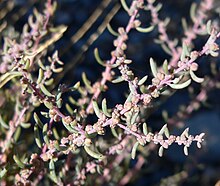Suaedoideae
| Suaedoideae | |
|---|---|
 |
|
| Suaeda nigra | |
| Scientific classification | |
| Kingdom: | Plantae |
| (unranked): | Angiosperms |
| (unranked): | Eudicots |
| (unranked): | Core eudicots |
| Order: | Caryophyllales |
| Family: | Amaranthaceae |
| Subfamily: |
Suaedoideae Ulbr. |
| Genera | |
|
about 2 genera, see text |
|
about 2 genera, see text
The Suaedoideae are a subfamily of plants in the Amaranthaceae family (now including the former Chenopodiaceae family).
The Suaedoideae have well-developed leaves. Except for genus Bienertia, the leaves show a central and many lateral vascular bundles. The leaves are neither decurrent nor amplexicaul.
The inflorescences are axillary cymes. The flowers are sitting free in the axils of bracts, with lateral bracteoles. The perianth consists of 5 tepals, which are more or less fused basally. 5 stamens are present. The seed encloses a spiral embryo, mostly without any perisperm.
The Suaedoideae have a nearly worldwide distribution. They are important members of the vegetation of shores and salty inland habitats. They are especially common in dry (arid) regions.
Among the species of Suaedoideae, there are nearly equal numbers of C3-plants and C4-plants. During the evolution of the subfamily, the C4-photosynthesis pathway seems to have been derived from four independent origins: two times with Kranz C4 anatomy in Suaeda section Salsina and Suaeda section Schoberia. Two independent origins of non-Kranz C4 systems are found in Bienertia and Suaeda section Borszczowia. In these plants, the photosynthesis pathways are located without spatial separation in a "single cell C4" type.
According to phylogenetic research by Kapralov et al. (2006), the Suaedoideae are grouped in 2 tribes:
...
Wikipedia
